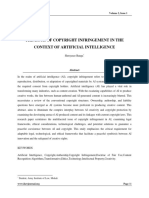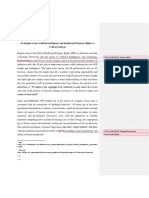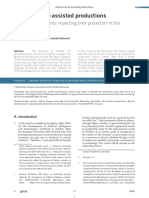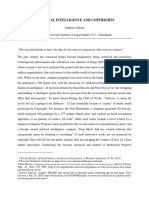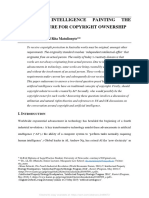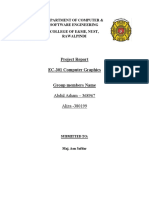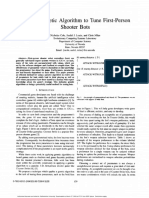INDIAN JOURNAL OF LAW, POLITY
AND ADMINISTRATION
COPYRIGHTABILITY OF AI GENERATED WORKS- A CRITICAL ANALYSIS
ADITHYA R
Christ (Deemed to be University)
Abstract:
Artificial Intelligence (AI) is one of the highly advanced technologies. It has potential to
revolutionize all the sectors ranging from satellite operations to creation of art. AI is already
utilized in various industries and one of them is the creative expression field. AI uses
programming languages to involve in creation of artistic, literature and musical works. These
works are similar to the works created by humans and in many cases the AI generated works
cannot be distinguished from human created works. With AI technology becoming more and
more advanced; the artistic works generated by AI are also significantly increasing. This
implies that more and more of this artistic work are contributed to economy which requires
certain protection from being copied. Law provides protection to the author and owner of the
eligible works through copyright law which is one of the branches of Intellectual property
law. At present the Indian legislation is silent on AI generated works. In this paper, the author
has explained whether AI generated work can be provided copyright protection, how AI
generated work differs from computer aided works and how granting IP protection to AI
generation works will impact present legal system. The author has also tried to find whether
AI can create work individually and whether the work would constate to be an original
creation; the author has applied the doctrines of Sweat of brow theory and Modicum of
creativity theory to analyze whether AI generated works falls under Original work. The
author has also analyzed the position of other jurisdictions on this issue. Finally, the author
provides suggestions for desired action required to be taken to in order to catch up with this
new technology.
Keyword: Artificial Intelligence, Copyright, Creative work, Originality
I. Introduction:
1
� INDIAN JOURNAL OF LAW, POLITY
AND ADMINISTRATION
In this 21st century the devices around us have reached to newer scales in technological
advancements. They have started to assist us in most activities of our day-to-day life, that it
has become inalienable part of our lives. These devices arenot only just machines which does
mechanical works but also developed to an extent of performing most of the works which
were once exclusively done by humans. This improvement is due to the Machine learning
technology which empowers the device to learn from input data and develop new works from
input data. Throughout the world AI technology is progressing at rapid pace. Artificial
intelligence is the ability of a computer program or a machine to think and learn, they process
the data provided as input and arrives at the programmed output.Presently A.I.’s
hasdeveloped to the extent of creation and generation ofworks, for instanceAmper an AI
machine capable of music composition, production, and performance had been involved in
production of Musical album1,similarly an AI Aiva has been involved in generation of
Classical sound track2, AI’s have also started to contribute in the creation of Art3, Sculpture4 ,
Video Games etc. These are few examples which illustrate how Artificial Intelligence is
involved in development of creative works. This leads us to the question of whether these AI
generated works possess originality and can these works be protected through Copyright
laws.
II. AI and Copyrights:
2.1 Artificial Intelligence:
The complete vision of A.I. was first articulated by Alan Turing, in 1950 he authored an
article “Computing Machinery and Intelligence”, and through this article he introduced the
1
Dom Galeon,“The World’s First Album Composed and Produced by an AI Has Been Unveiled”, Futurism,August. 21,
2017,available at <https://futurism.com/the-worlds-first-album-composed-and-produced-by-an-ai-has-been-
unveiled>(last visited on Dec. 13, 2020).
2
Bartu kaleagasi, “A New AI Can Write Music as Well as a Human Composer”,Futurism,March 9, 2017, available
at<https://futurism.com/a-new-ai-can-write-music-as-well-as-a-human-composer>(last visited on Dec. 13, 2020).
3
Katy Cowan, “Meet AI-Da: The World’s First Robot Artist capable of drawing people from Life”, Creative
boom,June.04, 2019, available at <https://www.creativeboom.com/inspiration/meet-ai-da-the-worlds-first-robot-
artist-capable-of-drawing-people-from-life/> (last visited on Dec.17, 2020).
4
James Vincent,“This AI-generated sculpture is made from the shredded remains of the computer that designed
it”, The Verge,Apr. 12, 2019,available at <https://www.theverge.com/tldr/2019/4/12/18306090/ai-generated-
sculpture-shredded-remains-ben-snell-dio> (last visited on Jan. 08, 2021).
2
� INDIAN JOURNAL OF LAW, POLITY
AND ADMINISTRATION
concepts of Machine learning, reinforcement learning5,in 1956 McCarthy proposed the
terminology ‘Artificial Intelligence’, later he founded LISP6 an AI programming language
which paved way for the modern sophisticated Artificial intelligence systems. The A.I.
technology has since grown to carry on the activities such as learning, decision making,
problem solving etc. Though there have been many attempts to define Artificial Intelligence
the most inclusive and accepteddefinition is that Artificial Intelligence is the study of how to
make computers do things which, at moment, people do better7.
2.2. AI Generated works:
With rapid development of technology,A.I. has been involved in creation of many aesthetical
works such as Art, Paint, Musical work etc. The Artists andAI developers program the
algorithms to “learn”an aesthetical workby analyzing set number of input data. After input of
datathe software then attempts to generate new works based on learning from input
data8.Incircumstanceswhere there is human interferencein creation of Art there is no dispute
over the Intellectual property rights of these creations as the Creator or Producer has rights
over it based on the type of creation, but for works that are generated without human
interference as in the case of GAN the ownership of the work is disputable. Countries around
the world have taken different stances based on their domestic laws and many countries are
ambiguous position over granting Copyrights to A.I. generated product. This also raises
question whether A.I. can be given stature of legal personality.
According to Section 13 of the Copyright Act there are 2 basic requirements for granting
Copyrights, they are:
1. The work should be an Expression.
2. And the expression should be Original.
In practice it remains unsettled over the dilemma of whether authorship and ownership rights
can be given to Artificial Intelligence as it is a non-Juristic personality. In cases where the
5
Stuart Russell, Peter Norvig, Artificial Intelligence: A Modern Approach 45 (Pearson Education, London,
2007)
6
Ibid.
7
Elaine Rich, Kevin Knight, et.al., Artificial Intelligence3 (McGraw-Hill, NewYork, 1991).
8
AI is blurring the definition of artist, American Scientist, Nov. 10, 2019,available at
<https://www.americanscientist.org/article/ai-is-blurring-the-definition-of-artist> (last visited on Jan.11, 2021).
3
� INDIAN JOURNAL OF LAW, POLITY
AND ADMINISTRATION
creation has been created using Human input, the work would fall on the ambit of Computer-
Generated work and law provides protection for such computer-generated worksbut in
circumstance where Human input is not present there can be two approaches either to
completely deny copyright protection for such works and the other option would be to
provide ownership rights to the creator or owner of the A.I. Technology9.
Difference between Computer Generated work and Artificial Intelligence generated work:
Computer generated works are recognized in Indian Copyrights act10. The provisionprovides
that when any literary, dramatic, musical or artistic work is generated by computer, the
authorship rights would be vested with the personwho causes the work to be created. The
authorship of any work created using Computer, lies with the Author of the work and
generally, the authorship lies with the person who made necessary arrangements for the
creation of the art11.In cases where a work is created by Human with help of A.I., this
provision could be used to gain rights over the work, butin caseswhere aesthetic work has
been created by AI with no human interference the authorship of the Work cannot be
provided through a single blanket solution and depends upon facts of user action12 and policy
of the country. At present A.I. technology such as Deep reinforcement learning systems are
prevalent but they lack creativity and are dependent on human13 but researchers have already
started to work towards inventing a new set of sophisticated AI technologies known as
Artificial General Intelligence (AGI) which exhibits Human like intelligence. This
technology if comes to reality would be able to create works on its own without any human
input and interference.
III. Originality of creation:
A.I. by itself cannot involve in creation of a work, it needs requisite program, input data and
instructions to involve in generation of works. AI processes the data, analyses the instruction
to produce a new work. Generally,AI uses a class of algorithmknown as Generative
9
Andres Guadamuz, Artificial intelligence and copyright,WIPO,October 2017, available
at<https://www.wipo.int/wipo_magazine/en/2017/05/article_0003.html> (last visited onJan17, 2021).
10
The Copyrights Act, 1957 (Act 14 of 1957), s. 2 (d) (iv).
11
Supra note 9.
12
See Supra note 9.
13
Can AI ever learn without human input? These researchers think so, Elsevier, available at
<https://www.journals.elsevier.com/neural-networks/news/can-ai-ever-learn-without-human-input>(last visited
onJan19, 2021).
4
� INDIAN JOURNAL OF LAW, POLITY
AND ADMINISTRATION
adversarial networks (GANs)14 to generate artistic works. GANs help in generation of new
works which will be then evaluated by Discriminatory adversarial networks.Section 13 (1) (a)
of Copyrights Act stipulates that Copyright can be provided to Original literary works only15.
The act does not define the term “Original’, but it is a settled position that Originality in
expression of thought is requiredrather than the Originality of idea16.In the case of Thomas v.
Turner (1886) the court decided that Copyright protection would not be given when there is
trivial correction or alteration is made to pre – existing work17, similarly when an A.I.
compiles the given setand arrives at new work based on the amount of correction and
alteration made the work can be concluded as Original work or not. In the case of Eastern
Book Co v Navin J Desai, the court held that when modifications are of trivial nature,
copyright cannot be provided to that work18. Hence originality can be attributed to work that
have major and important changes from the source work.There are 2 major doctrine on
deciding whether a work can be termed as Original or not;
1. Sweat of Brow doctrine: According to this doctrine the Copyright is provided not based on
originality of idea but based originality in expression of idea through efforts such as
Selection, Judgment and experience. In the case of Macmillan v. Cooper (1923)19, it was held
a compilation would attract Copyright if the author has used ‘selection, judgment and
experience’, in case of A.I. generated work the A.I. on the instruction of the codes processes
the set given data to arrive at new work through Automated reasoning, when an A.I. compiles
these given sets it uses Selection and Judging process to create the new work.
2. Modicum of Creativitydoctrine:According to this doctrine a work in order to be qualified
as Original should contain at least minimum amount of intellectual creativity and Judgment
involved in creation of that work. In case of A.I. generated works though Judgmental process
is involved in selection of required features from input data, the intellectual creativity is
disputable but A.I. exhibits Intellectual creativity in analysis and selection of relevant portion
of data.Thus, on application of the twomajor doctrines on Originality it can be concluded that
14
See Supra note 9.
15
The Copyrights Act, 1957 (Act 14 of 1957).
16
RG Chaturvedi, Iyengar’s: The Copyright Act 92 (Universal law publishing, Allahabad, 2010).
17
Id. at 30.
18
(2001) PTC 82(Del).
19
(1924) 40 TLR 186.
5
� INDIAN JOURNAL OF LAW, POLITY
AND ADMINISTRATION
works generated through Artificial Intelligence exhibits characteristics in order to be
qualified as Original works.
IV. Granting Authorship rights to A.I.:
A.I. creates work throughinstructions and after providing certain data.Whenthe work is done
without any human interference, the work may be considered as work involving Selection,
judgment and experience and in such cases, authorship right can be granted at theorical level.
There are certain rights which are provided by Copyrights law to an Author, these rights can
be classified into 2 set of rights. One is Economic rights; the next set of rights is Moral
rights.The economic rights subside with the Owner of the Work, but Moral rights are
provided exclusively for the author of the work. Section 57 of the Copyright act provides for
Moral rights, these rights are independent from ownership of the work. Here the author is
provided with right to claim authorship of work in case of Publication etc., the author is also
provided with right to restrain or claim damages in case of any mis-happenings to the work.
In case of A.I. being given authorship rights the A.I. cannot be able to exercise the Moral
rights which are generally provided to the author. One of the major arguments against
granting authorship rights to A.I. is that the A.I. generated works are mere Compilation and
that the work lacks Originality. But these types of works are recognized as work of
compilation and the person who collects and arranges the entire work would be generally
considered as Author of the work20. According to legal personality theory rights and
obligations can be provided only to Legal subjects who has own will whereas it cannot be
vested on animals and non-living materials they are mere objects of law. Hence though IP
law is favourable for giving authorship rights to AI but as AI is not subject of law the IP laws
has to be updated over this issue.
4.1.Author, Owner Dilemma:
When the Author does the work for the consideration of a person, i.e. Contract ofservice the
employer gets the Ownership of the work and when the work is done during the course of
employment the Employer automatically gets ownership of the Work whereas the author can
claim for authorship rights. But in case of A.I. dilemma arises about whether who should be
given ownership rights as it is not involved in employment but in case of economic-work
20
V K Ahuja, Law of Copyright and Neighboring Rights 54(LexisNexis, Mumbai, 2007)
6
� INDIAN JOURNAL OF LAW, POLITY
AND ADMINISTRATION
environment, the ownership rights can be granted to the Owner or user company of the A.I.
as these work and related ownership rights would be the reason for purchasing the A.I. and if
not for providing these rights to them the sole purpose of purchasing the A.I. would be
defeated causing economic loss.Hence in such circumstance considering the economic
purpose for which the AI was purchased and considering the legal personality theory, AI
cannot be provided with Ownership right but granting authorship rights can be considered
upon.
V.Legal Position in otherjurisdictions:
5.1. Legal position inUnited Kingdom:
The copyright law in UK is similar to that of copyright law practiced in India. According to
Section 9(3) of the CDPA, authorship rights are provided to the person who makes necessary
arrangements for the creation of the work21. This is similar to Section 2(d) (iv) of the Indian
Copyrights act, 1957, which recognizes Computer generated works. This can be interpreted
as person who made necessary arrangements can be provided with Authorship rights. But the
term person who made necessary arrangements is vague and can be used by both the AI
developer as well as present possessor of AI who would have made necessary arrangement by
feeding data and instructions and the technology is just used for mere processing of input
data. Hence this could not be used to conclude whether AI generated works can be given
copyright protection.
5.2. Legal position inUnited States of America:
According to US copyright Act, 1976 a work has to be created by Author in order to attract
Copyright protection. According to § 306 of Compendium of U.S. Copyright Office
Practices, Third Edition22, Human authorship is required in order for registering a work as
original work. It protects works only by intellectual labor which is found in creative powers
of the mind. One of the prominent examples is the ruling of “Naruto” monkey selfie
copyright dispute case wherein the monkey had clicked a picture of selfie using unattended
camera of British wild life photographer, with regard to requirement of Human intellectual
21
UK Copyright, Designs and Patents Act, 1988, s. 9(3).7
22
U.S. Copyright Office, Compendium of U.S. Copyright Office Practices, 2017, s.306.
7
� INDIAN JOURNAL OF LAW, POLITY
AND ADMINISTRATION
input is the Office will not register works produced by a machine or mere mechanical process
that operates randomly or automatically without any creative input or intervention from a
human author.Similarly, US Supreme Court in an 1879 case held that Writings are found only
in Creative powers of mind23. Hence any work which is generated by AI individually cannot
be granted Copyright, but when a work is created using human input that person would be
provided with authorship rights.
5.3. Legal position in Japan:
According to Article 2(a)the term of Japanese Copyright Act,"work" has been defined as a
production in which thoughts or sentiments are expressed in a creative way24, this restricts AI
generated work from copyright protection as thoughts or sentiments are absent in AI
generated it exhibits only Judgmental skill and not thoughts or emotion. But whereas when an
work is created by AI through human input with regard to any of above mentioned
thoughtsthe work would qualify for copyright protection.
VI. Economic aspect:
Granting certain set of protection to A.I. generated works is an important and required action
because the economic nature involved in creation, selling, distribution of economic valuable
works needs to be recognised. A.I. is capital extensive technology which drives technological
advancement towards future and conferring authorship and ownership rights to A.I. generated
work is required to meet the expenses involved which is essential for the investors to recover
the investments made towards creation and setting up Artificial intelligence
technology.Artificial intelligence is already being used to generate works in music, art,
journalism, creative works etc. These economic valuable goods require protection from being
copied and used. Not providing adequate legal protection would have chilling effect on the
development of automated systems. The A.I. technology is not only capital extensive but also
knowledge extensive technology which requires great effort to be taken inorder to develop
23
100 U.S. 82 (1879)
24
Natsuko segawa, ‘JapaneyesrightsprotectionforAIartwork’, Nikkei: Asian review, April. 15, 2016, available
at<https://asia.nikkei.com/Economy/Japan-eyes-rights-protection-for-AI-artwork>(last visited on Feb. 03, 2021).
8
� INDIAN JOURNAL OF LAW, POLITY
AND ADMINISTRATION
such technology. Hence protection of A.I. developed work would encourage development of
such technology in future25.
VII. Recommendations and Conclusion:
The authorship and ownership of Works done by A.I. can be classified into 2 parts based on
interference of Human,
1. When the work is created byAI basedon human input apart from Source code and Data.
In this case the Ownership rights of the work can be vested with Human who provided the
Input. Similarly,the authorship rights can be provided to person who made the necessary
arrangement.
2. Where work is created by AI without human input, in such cases, the Ownership rights
of the work can be provided to the Human/ Company who owns the AI and the Authorship
right can be provided to the A.I. In such a case there requires certain modifications in
Copyright Act over Economic rights and moral rights of the Author, as AI is not a separate
entity to get involved in economic transaction and is not a juristic personality it cannot
enforce its rights in case of infringement. In such cases ‘next friend principal’ could be
adopted to protect the interests vested with A.I.
Though at present AI does not create a work individually without any human intervention,
with rapid development of technology the status quo may not remain the same in near future.
Hence pro-active steps may be taken by legal fraternity in order to protect the rights of the
stakeholders and to regulate and drive the technology towards better innovations.
25
Ryan Abbott, “I Think, Therefore I Invent: Creative Computers and the Future of Patent Law” 57 Boston
College Law Review1079 (2016).
9

